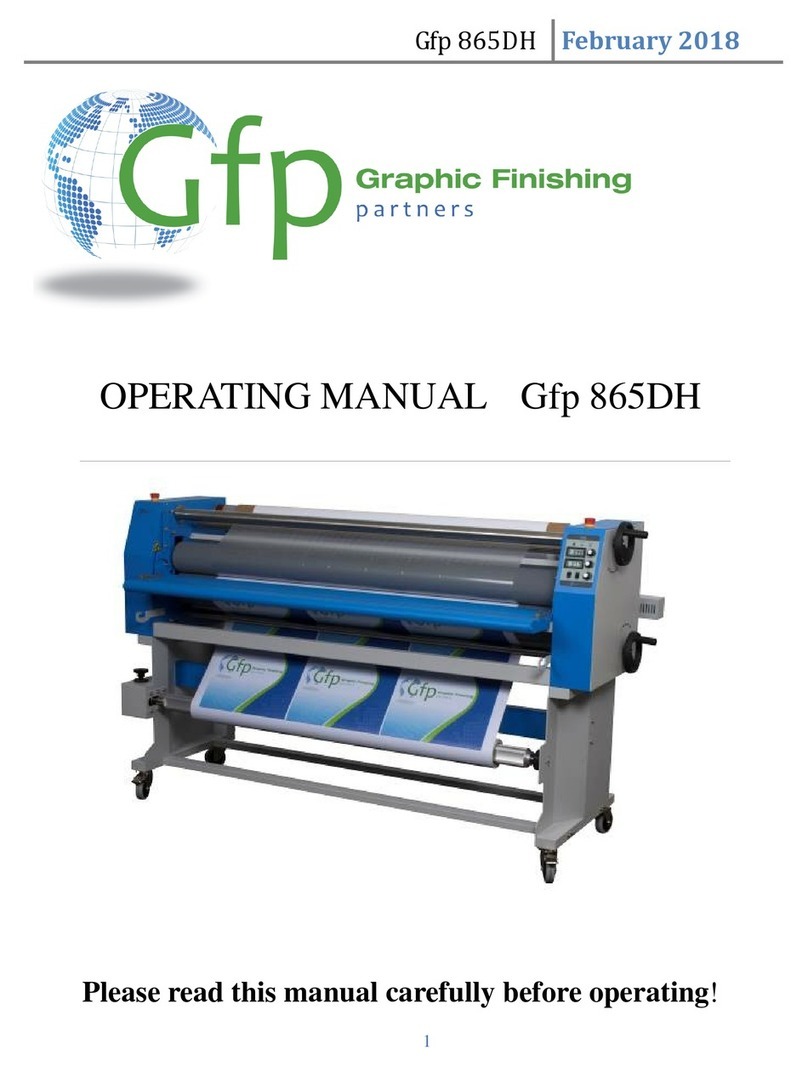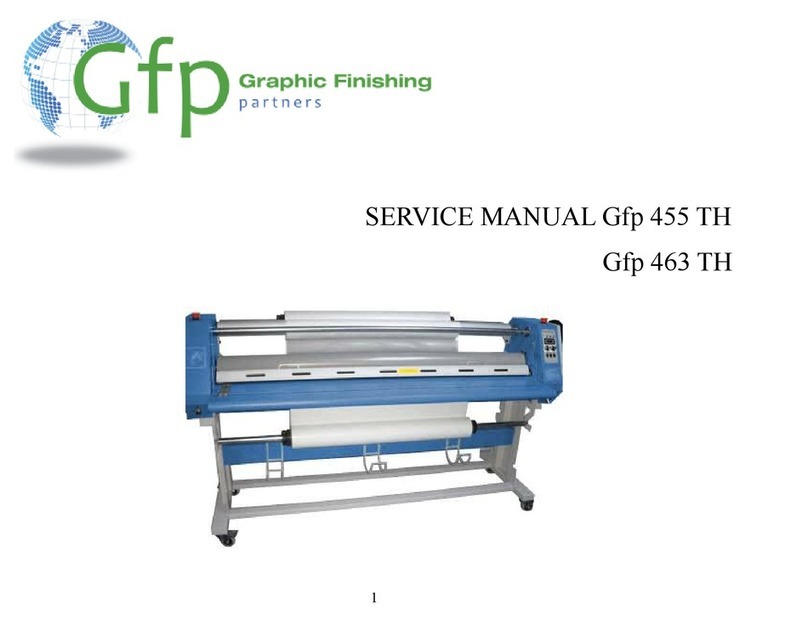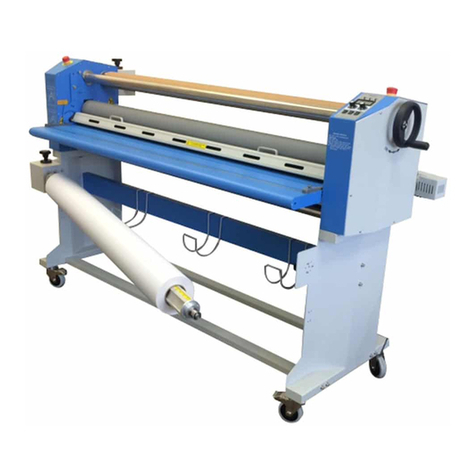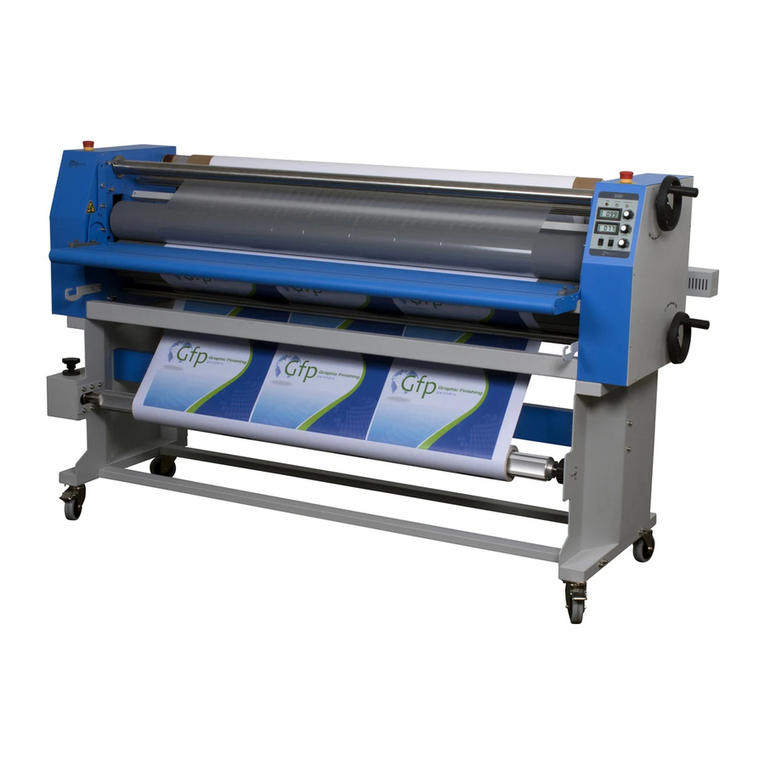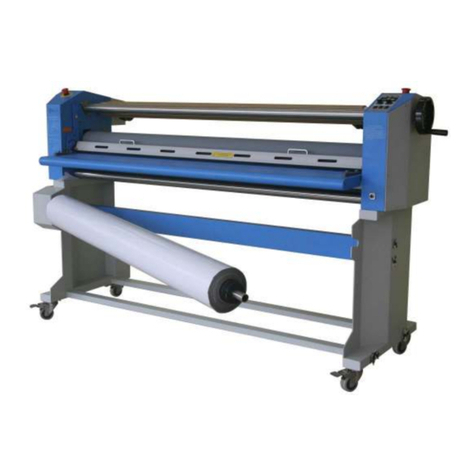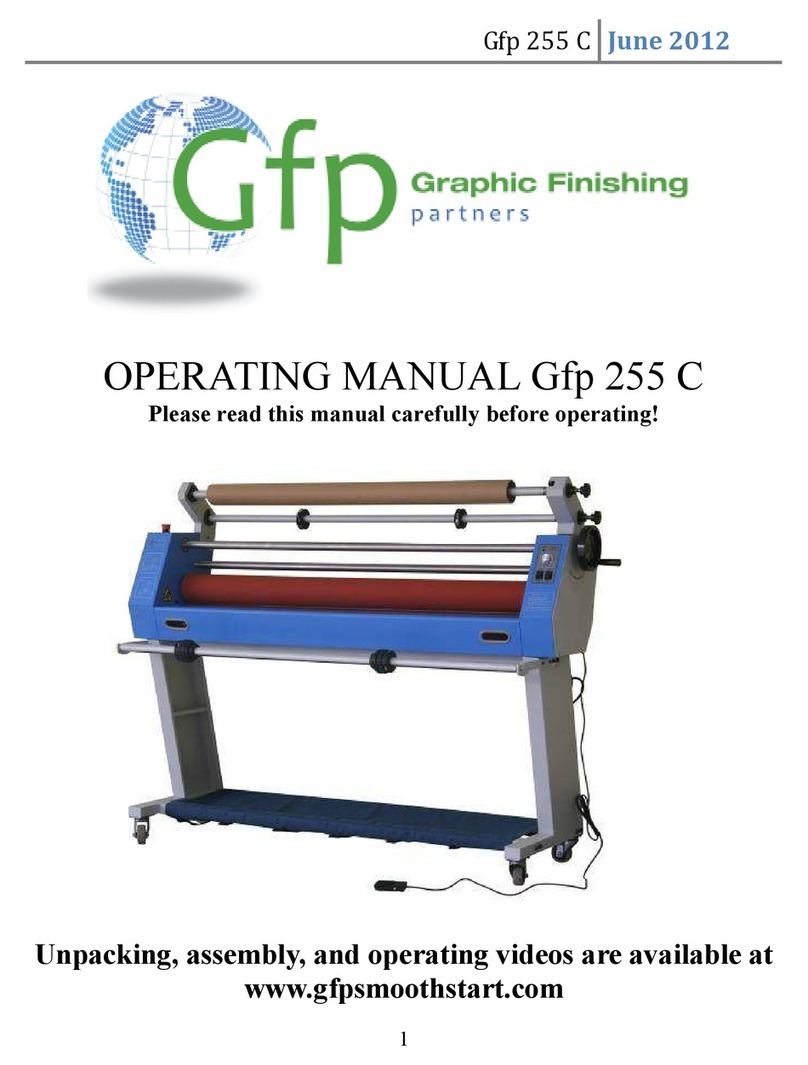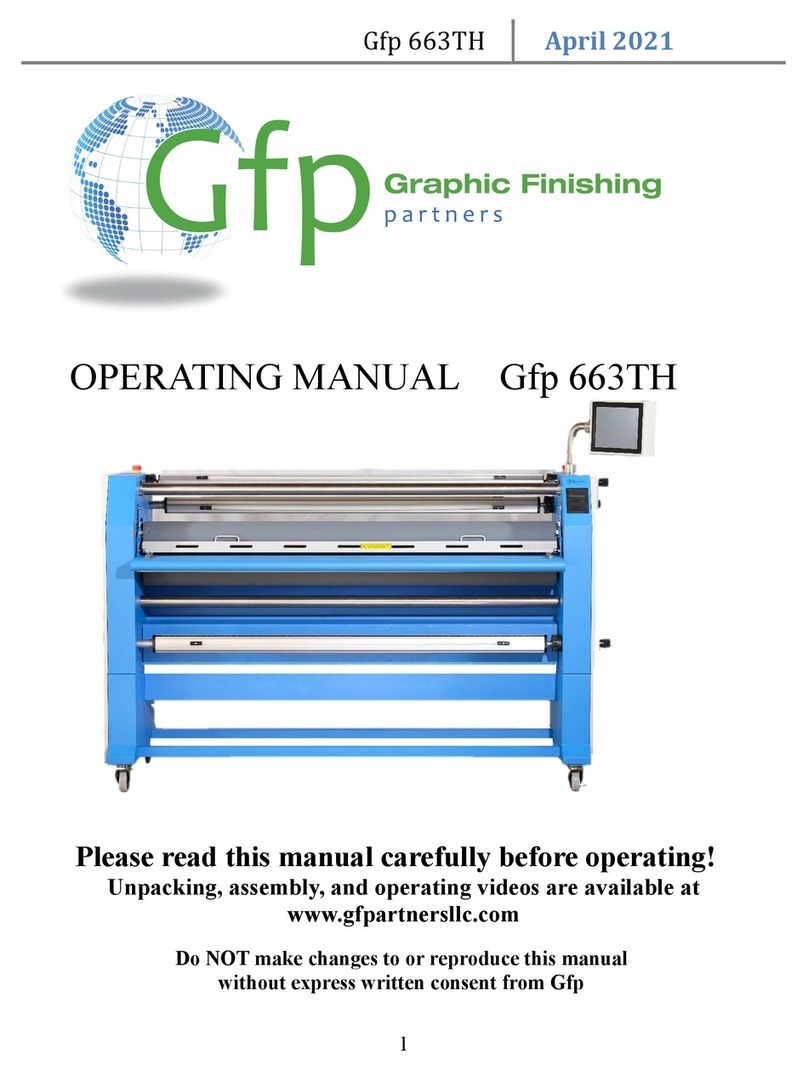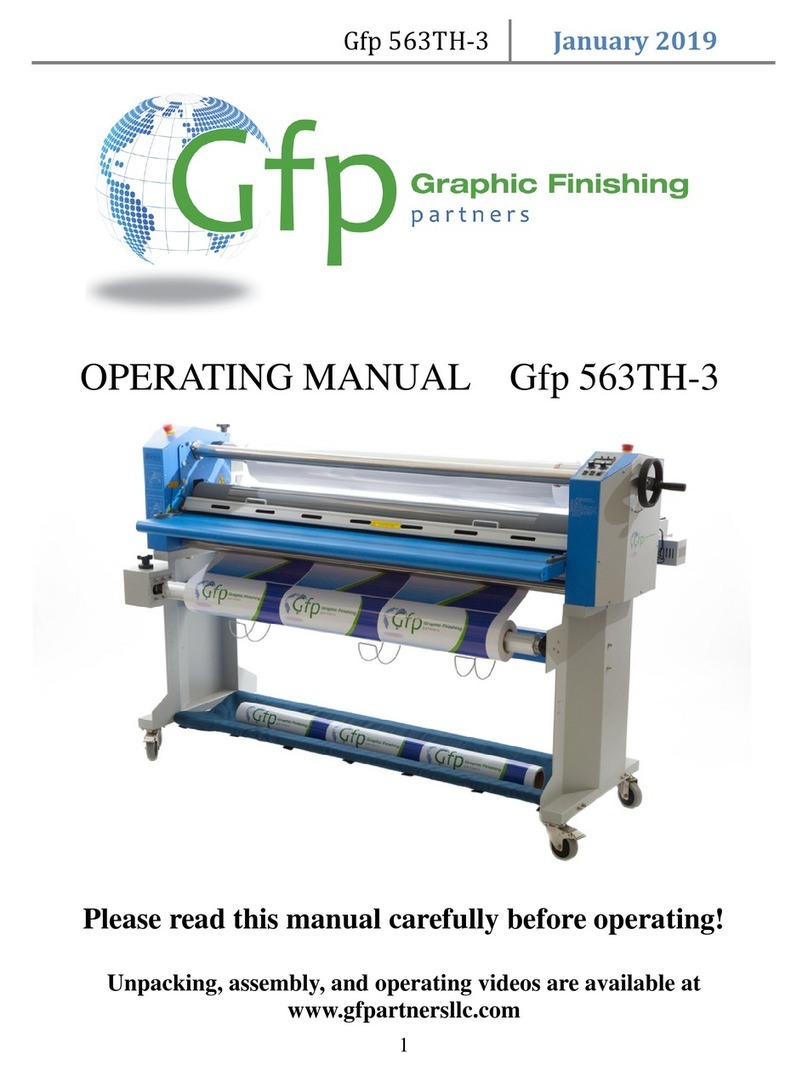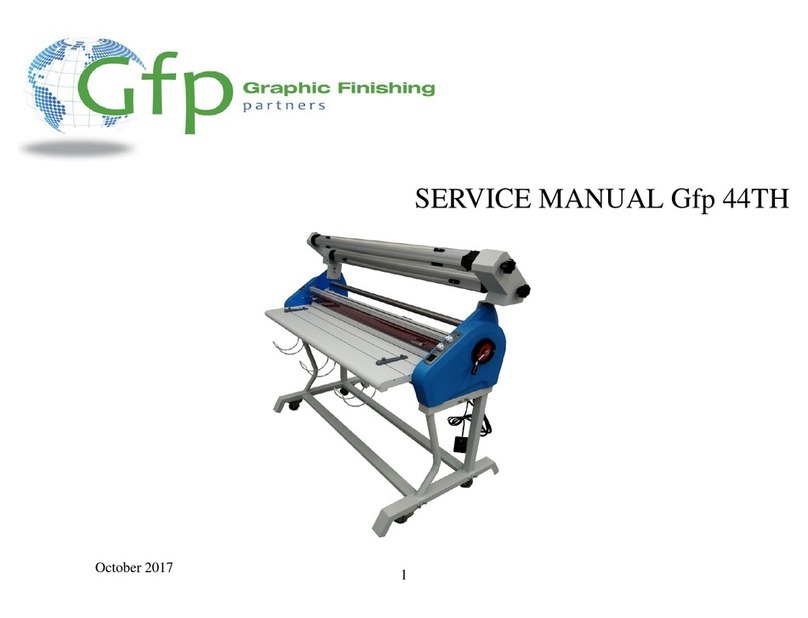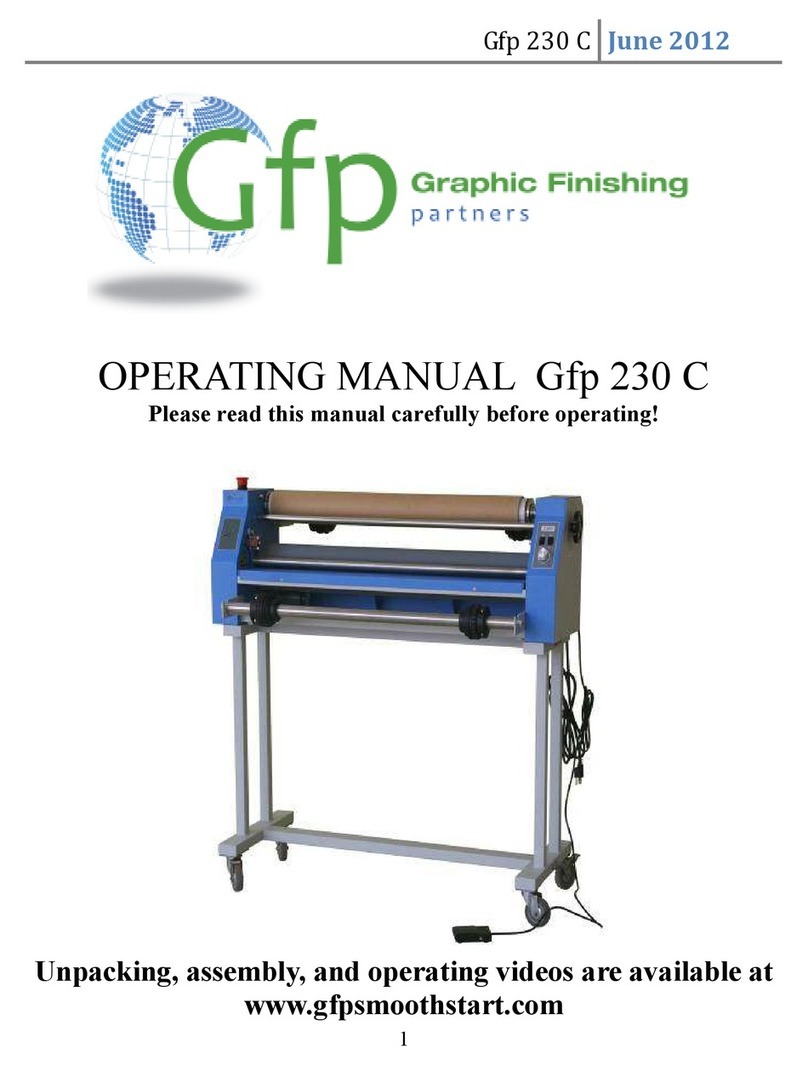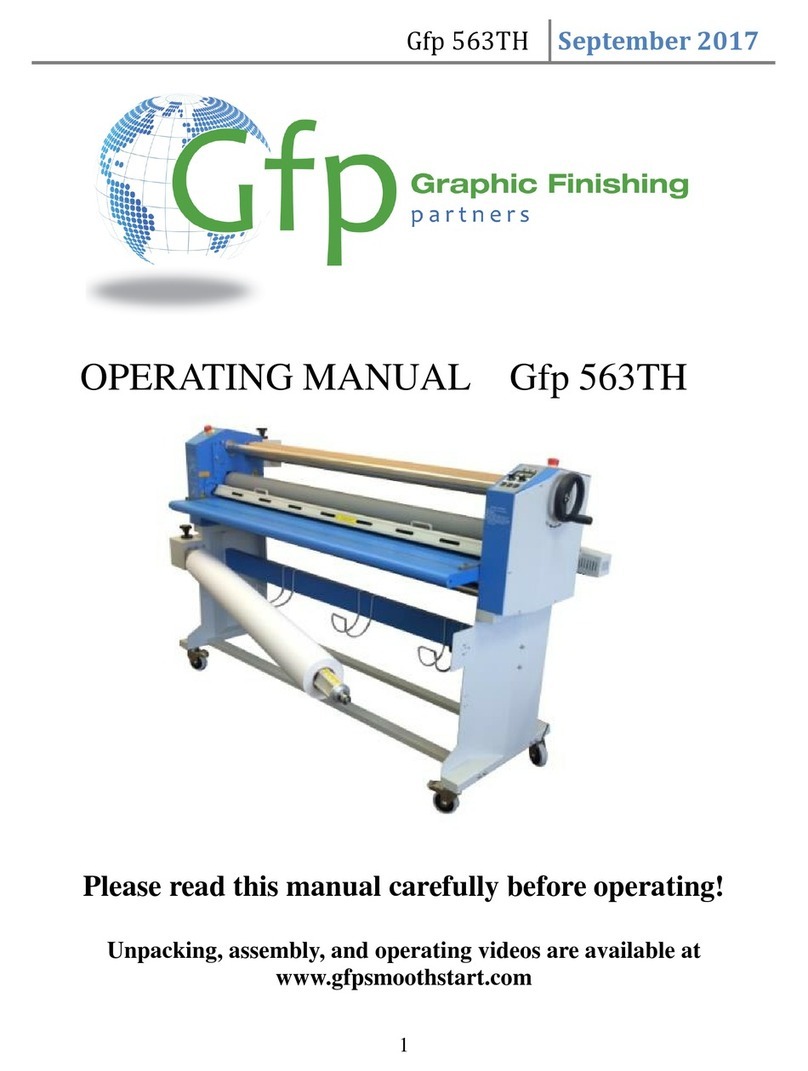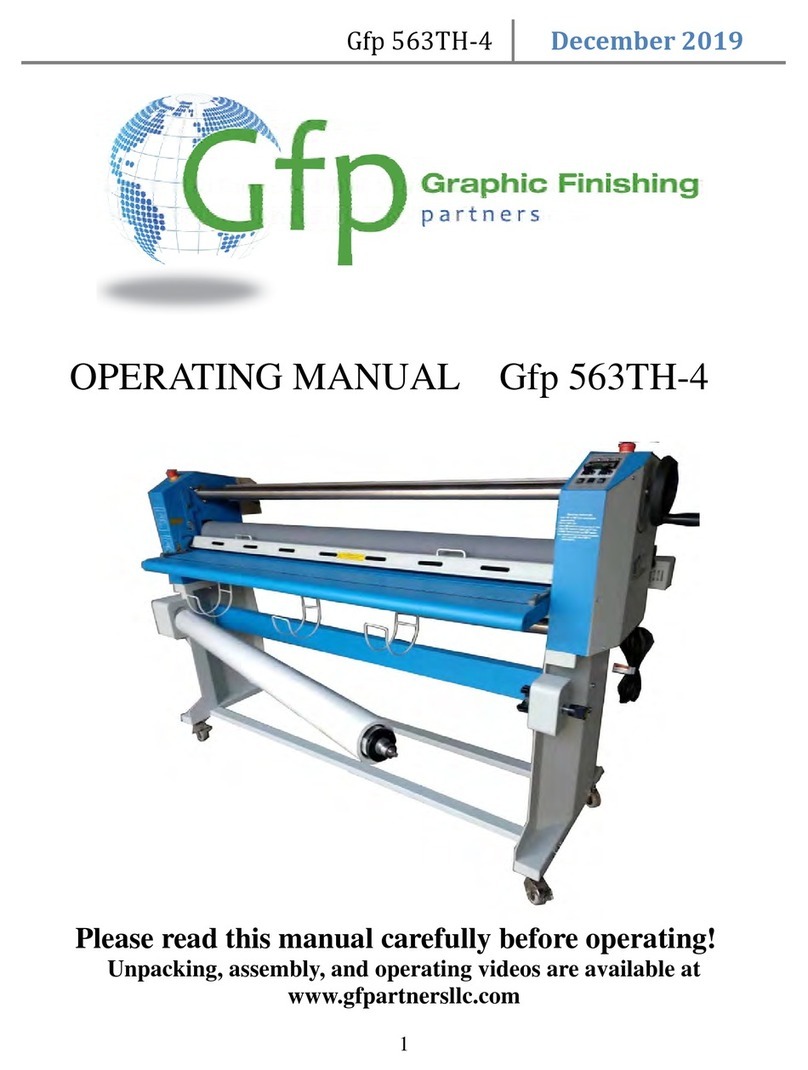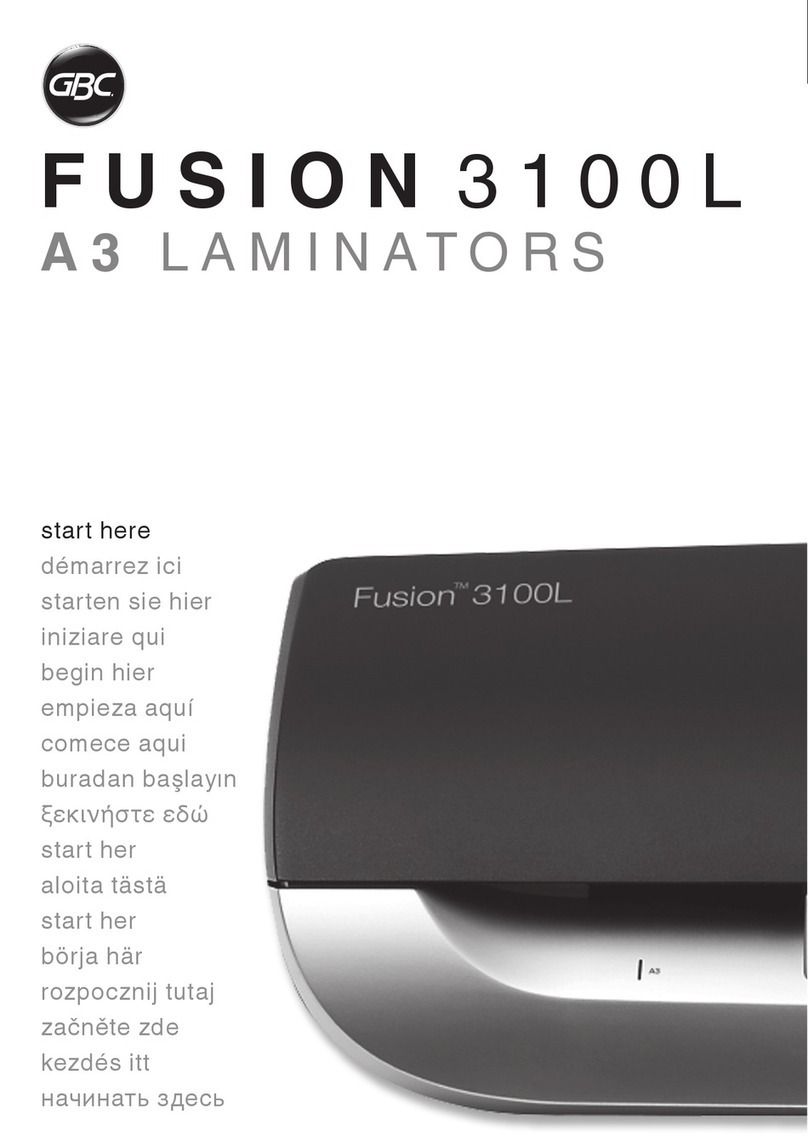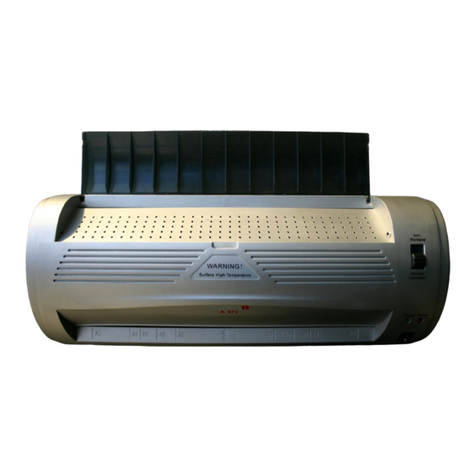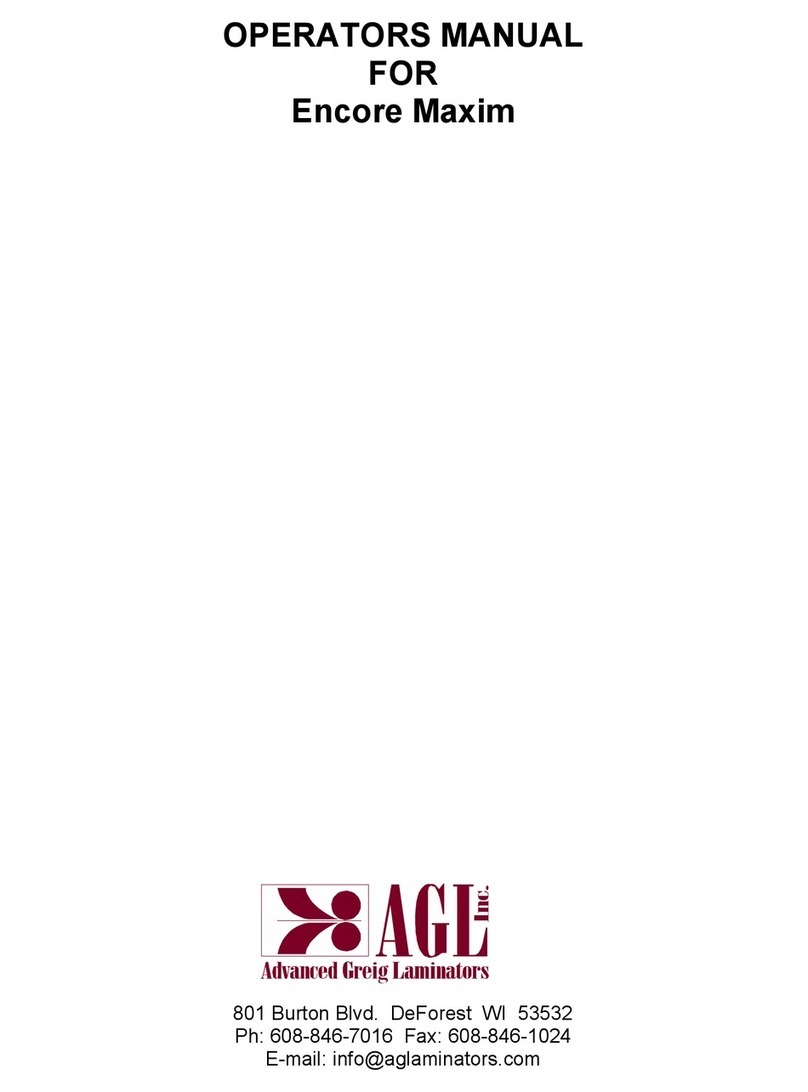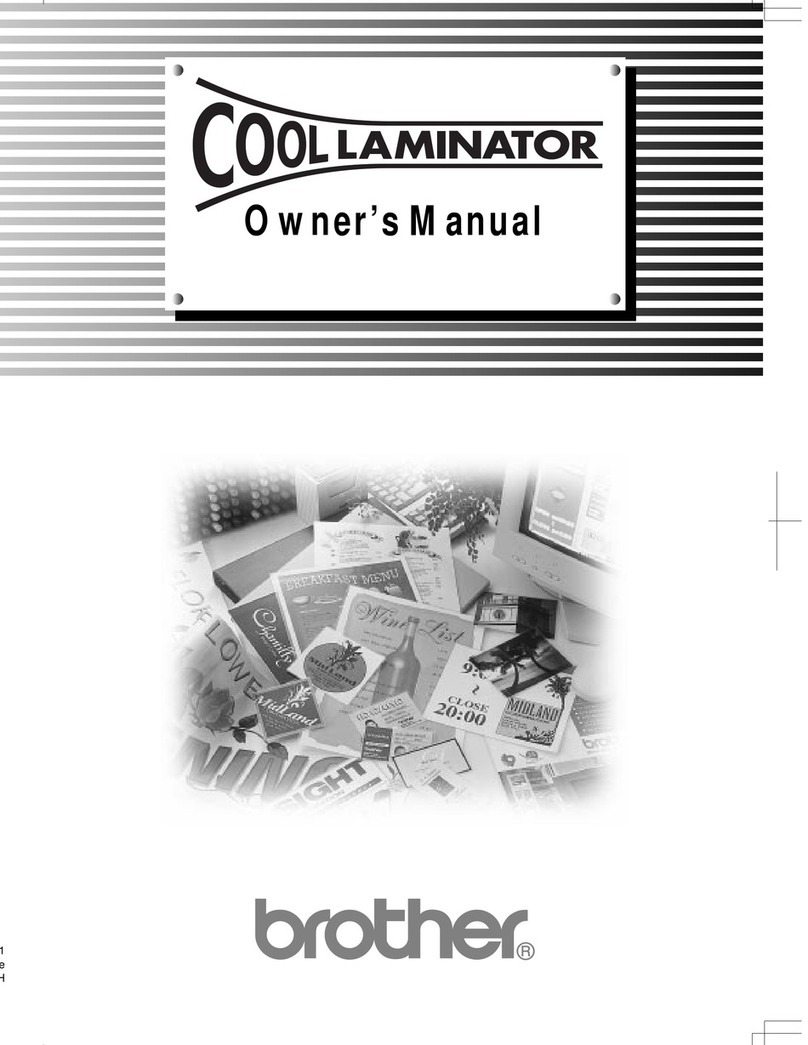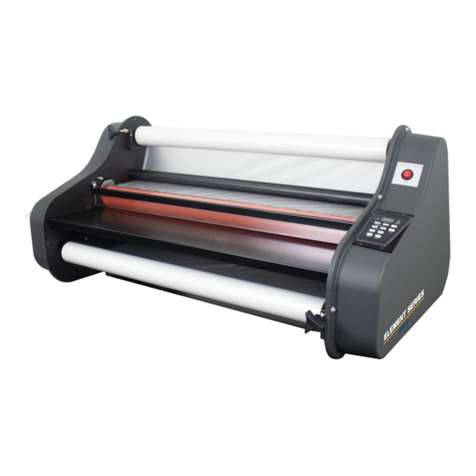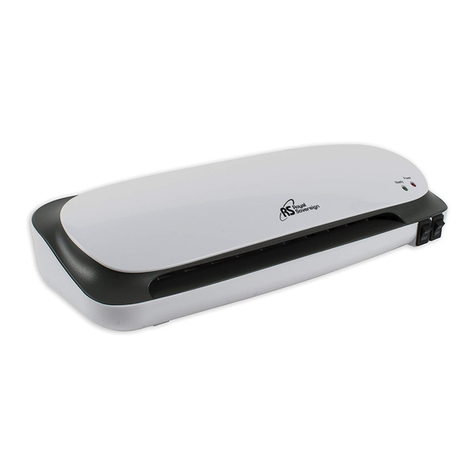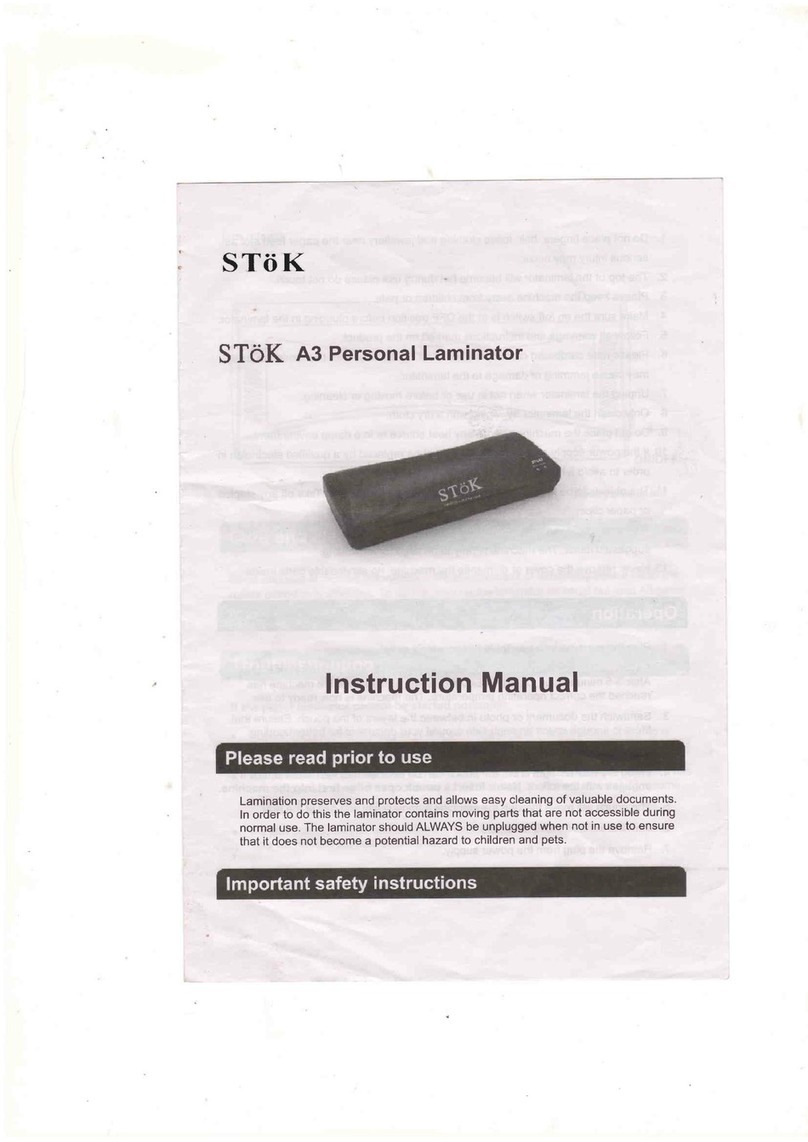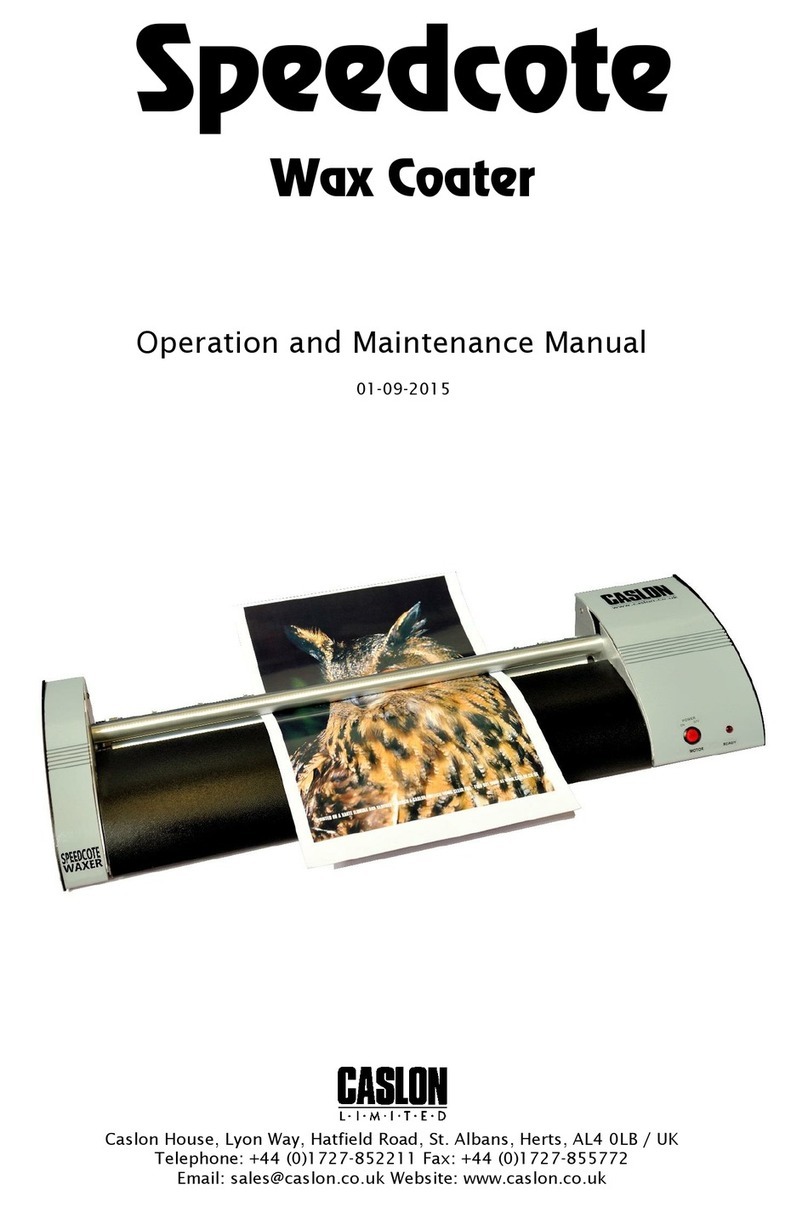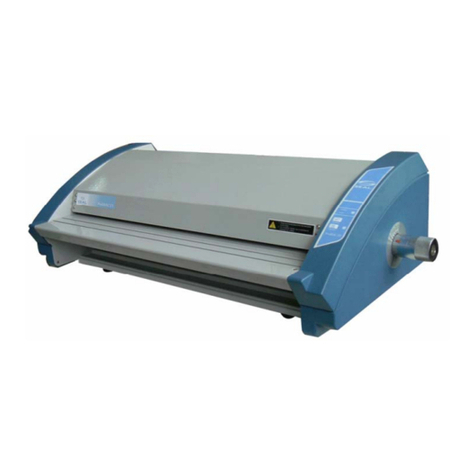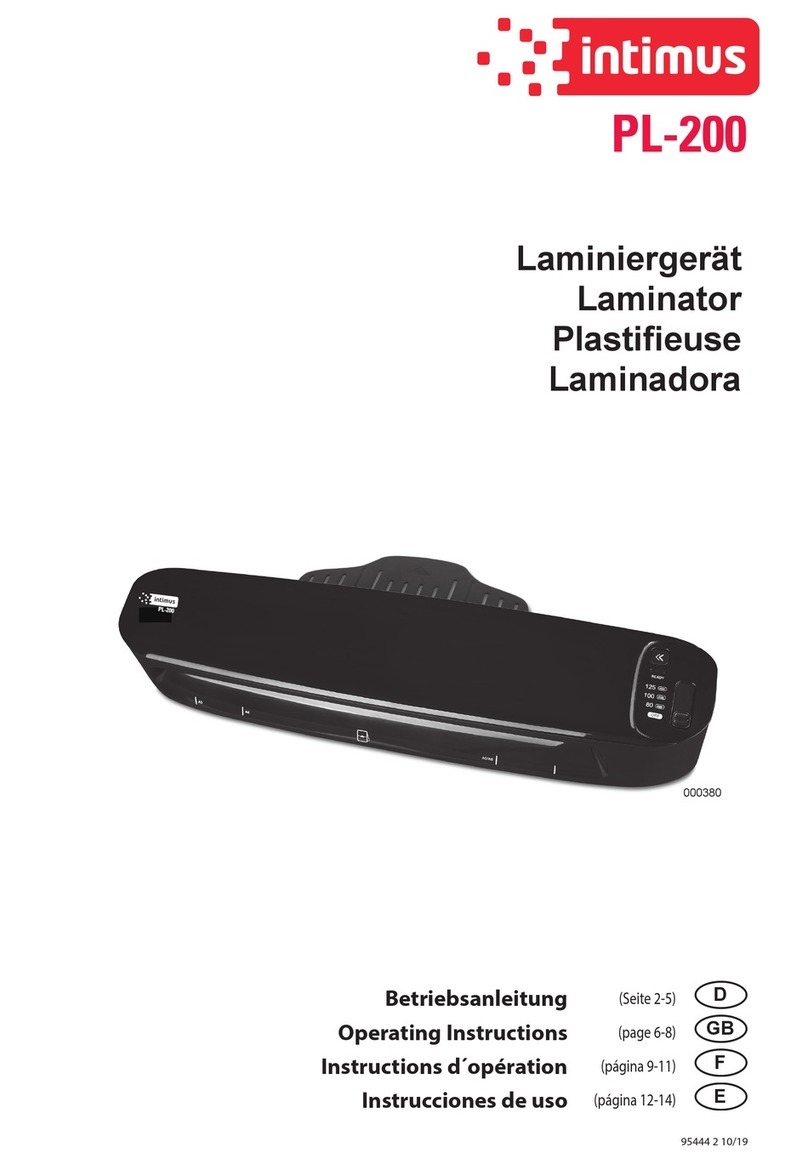Gfp 300TH Series User manual

Gfp 300 Series
June 2023
2
Table of Contents
Contents Page
1. Introduction ………………………………………………………..…..
2. Important Safety Instructions…………………………………….……
3. Installation Safeguards ….………………………………………….....
4. Regulatory Compliance Statement…….………………………….……
5. General Safeguards……………………………………………………
6. Operating Conditions……. ……………………………………………
7. System Components…… ……………………………………….…….
8. Control Panel….. …………………………………………………….
9. Packing List ….……………………………………………………....
10. Installation
A. Uncrate the machine………………………………………….…
B. Remove stand cross members…...…………………….……….
C. Assemble machine stand…….…………………………………..
D. Set Machine on stand……….…………………………………..
E. Bolt Machine to stand…..….…………………………………..
11. Additional installation items…….……….…………………………….
12. Loading upper shafts
A. Remove upper supply and rewind shafts…….………………….
B. Loading film and rewind shafts…………………………………
13. Loading bottom supply shaft
A. Media alignment disks…………………………………………..
14. Threading film…...………..……………………………………….......
15. Adjusting Brake/Clutch Tensions………...…………………………….
16. Operation..………………………………………………………..........
17. Roller gap………………………………………………………………
18. Laminating
A. Single sheets using a sled…..………………………………..…
B. Multiple sheets using a roll of Kraft Paper……………………..
C. Media from a roll…..………………………………………….
19. Mounting
A. Pre-coating mounting boards…..……………………………...
B. Mounting print to pre-coated mounting board…....……….…..
20. Troubleshooting …...……………………………………………….…
21. Specifications……………………………………………………….…
22. Warranty…………………………………………………………….…
3
3
3
4
5
6
7
8
9
10
11
12
13
14
14
15
16
17
18
19
20
20
21
21
22
23
23
24
25
26

Gfp 300 Series
June 2023
3
1. Introduction
Thank you for choosing a Gfp 300 Series laminator. It has been designed and manufactured to provide
years of continuous service. Please read this manual thoroughly before operating. Please inspect the box
and the laminator for shipping damage. Damage should be brought to the attention of the delivering carrier
immediately
We reserve the right to make changes to this publication and to the products described in
it without notice. The details given in this manual are based on the most recent information available to
us. They may be subject to change in the future. We retain the right to make changes to the construction
or the design of our products without accepting any responsibility for modifying earlier versions
WARNING! Any unauthorized changes or modifications to this unit without our prior written approval
will void the user’s warranty and will transfer health and safety obligations to the end user.
CAUTION! Please pay attention to all passages with these symbols. This information is
vital to preventing user injury and/or damage to the unit. Failure to follow this information could void the
user’s warranties and transfer all safety obligations to the user.
2. Important Safety Instructions
In this operating manual you will find important safety messages regarding the product.
Read these instructions carefully, failure to comply with the following safety procedures could result
in serious injury.
WARNING Do not attempt to service or repair the laminator. Only authorized maintenance and
service technicians should make repairs.
WARNING Do not connect the laminator to an electrical supply or attempt to operate the laminator
until you have completely read these instructions. Maintain these instructions in a
convenient location for future reference.
WARNING To guard against injury, the following safety precautions must be observed in the
installation and use of the laminator
3.Installation Safeguards
•Shipping damage should be brought to the immediate attention of the delivering carrier
•Avoid locating the laminator near sources of heat or cold. Avoid locating the laminator in
the direct path of forced, heated or cooled air
•The receptacle must be located near the equipment and easily accessible.
•Connect the attachment plug provided with the laminator to a suitably grounded
outlet only. This machine must have reliable earth wire to ensure the safety of the machine
during operations
•Contact an electrician should the attachment plug provided with the laminator not match the
receptacles at your location

Gfp 300 Series
June 2023
4
•Ensure that the voltages of the power supply you are using match the rated working voltages
before operations. Do not use incorrect power supply
•Do not use damaged wires or sockets. If abnormal conditions occur, switch off the power
supply first.
•Only a licensed electrician should install wiring and outlet for the laminator
•Do not defeat or remove electrical and mechanical safety equipment such as interlocks, shields and
guards
4. Regulatory Compliance Statements
cTUVus Certification
This test mark, also referred to as the "cTUVus mark", serves as proof of compliance with US national
standards from UL adopted by OSHA and the Canadian national standards of CSA adopted by the
Standards Council of Canada (SCC). US Authorities having Jurisdiction (AHJs) and Provincial
Regulators across Canada recognize the cTUVus mark as proof of product compliance to published
national standards and code requirements. The cTUVus mark is officially recognized as an equivalent
and direct replacement of the UL and CSA marks.
Federal Communications Commission (FCC) Compliance Statement
This equipment has been tested and found to comply with the limits for a Class B digital device,
pursuant to part 15 of the FCC Rules. These limits are designed to provide reasonable protection against
harmful interference in a residential installation. This equipment generates, uses and can radiate radio
frequency energy and, if not installed and used in accordance with the instructions, may cause harmful
interference to radio communications. However, there is no guarantee that interference will not occur in
a particular installation. If this equipment does cause harmful interference to radio or television
reception, which can be determined by turning the equipment off and on, the user is encouraged to try to
correct the interference by one or more of the following measures:
—Reorient or relocate the receiving antenna.
—Increase the separation between the equipment and receiver.

Gfp 300 Series
June 2023
5
—Connect the equipment into an outlet on a circuit different from that to which the receiver
is connected.
—Consult the dealer or an experienced radio/TV technician for help.
Changes or modifications not expressly approved by the party responsible for compliance
could void the user's authority to operate the equipment.
5. General Safeguards
•Keep hands, long hair, loose clothing, and articles such as neckties away from rollers to avoid
entanglement and entrapment. The rollers have pinch points that can trap body parts or
clothing and cause serious injury
•Do not use the machines for purposes other than lamination and mounting, otherwise
damages to the machine or accidents may occur
•Keep out of reach of children
•Keep flammable and wet objects away from the machine.
•Do not use flammable sprays or materials when cleaning the machine
•Do not leave the machine unattended during operations.
•Do not mount metal materials or other hard objects.
•Do not put burrs, sharp blade or rigid materials in between the two rubber rollers.
•Do not attempt to laminate items that exceed total recommended material thickness of the
unit.
•Do not place foreign object inside the machine.
•Do not cut adhesive films directly on the surface of the rollers to avoid damaging the rubber
coating.
•Shut down the machine after laminating to avoid misusing this machine by others.
•Shut down the power before moving the machine
•Note the locations of foot wheels while moving or operating this machine to avoid injuries
to your feet.
•Disconnect from the power supply before repair or maintenance.
•Disconnect from the power supply when the machine is not in use for a long time.
•When the machine lies idle for a long period of time, raise the top rubber roller to avoid the
distortion of the rubber surface.
•Perform only the routine maintenance procedures referred to in these instructions
•Do not leave excess adhesive build up on the rollers overnight

Gfp 300 Series
June 2023
6
6. Operating Conditions
•Place machine on level surface
•Environment requirements:
Ambient temperature: 50⁰F - 104⁰ F
Humidity:30%—80%;ideal humidity:55%
•Due to the static on film rolls, you should try to keep the environment clean.
•Provide enough space around machine to ensure the safe and effective operation.
The minimum area covered is 8 ft. x 10 ft.
•Do not directly cut the films on the surfaces of the rubber rollers to avoid damages
to the rollers.
•Do not put burrs, sharp knives or extra thick and hard materials in between the
rollers. Do not leave objects like tools, rulers, knives, etc. on the working panels
or the side cabinets to avoid their being rolled into the machine accidentally and
damaging the rollers.
•For repairs and replacements, please contact your local distributor. Unauthorized
repairs and dismantling will affect future maintenances of the machines.
•The machine can laminate continuously objects less than ½” thick.
For objects over ½” but less than 1” thick, use the pedal switch.
Warning: Do not keep the machines in direct sunshine or near it.
Do not keep the machine in dusty place or places with strong vibrations.

Gfp 300 Series
June 2023
7
7. System Components
1. Left Cabinet
2. Pressure Adjustment linkage shaft
3. Top Rubber Roller
4. Bottom Rubber Roller
5. Right Cabinet
6. Roller gap adjustment Hand Wheel
7. Power Switch
8. Stand
9. Top supply shaft
10. Rear rewind shaft
11. Rear Exit panel
12. Anchor bolt.
13. Bottom supply shaft
14. Front cross member
15. Swing up feed tray
16. Emergency Stop Switch
17. Photo eye opening
17

Gfp 300 Series
June 2023
8
8. Control Panel
1. POWER on indicator 5. HOT Lamination indicator
2. Temperature adjustment Flashing = warming up / Solid on = Ready
3. RUN/FOOT pedal switch 6. Speed adjustment
4. FORWARD/ REVERSE switch 7. COLD/ HOT on switch
Note:
1. The machine does not have continuous reverse. Reverse can only operate using the pedal switch
2. If the photo-electric eye stops the machine, move operation switch to “FOOT” then back to
C
“RUN” to continue operation.
3. The photo eyes are located on each side frame and shoot a beam across the front of the rollers on
top of the feed table.
4. Beginning with S/N 1905355TH069 and 1903363TH043, the POWER indicator will start
flashing whenever an E-Stop switch is engaged. Release the E-Stop to continue running.
2
4
1
3
6
5
7

Gfp 300 Series
June 2023
9
9. Packing List
Remove all parts from shipping crate and boxes. Inspect parts and the machine
carefully. Any missing parts should be reported to the shipper upon receipt of
shipment.
Main Machine Crate
Part
Quantity
Part
Quantity
Main Machine
1
Allen Wrench 3mm
1
Quick-Grip shafts
4
Allen wrench 4mm
1
Stand locking screw
4
Allen wrench 6mm
1
Cardboard rewind tube
1
T-Allen wrench 5mm
1
Foot switch
1
Hex screw 8mm x 80
8
Zippy knife
1
Hex screw 8mm x 20
4
Cloth tray
1
Flat washer 8
12
Velcro Straps
7
Lock washer 8
12
Right stand side frame
1
Operating manual
1
Left stand side frame
1
Upper cross member
1
Lower cross members
2
Media alignment disks
2

Gfp 300 Series
June 2023
10
10. Installation
10A. Uncrate the machine
1. Remove screws holding the top cover to the crate side panels (figure 1)
2. Lift off the crate top and remove the supporting cross members from
the crate side panels (figure 2)

Gfp 300 Series
June 2023
11
3. Remove screws holding all 4 side panels to the skid (figure 3)
4. Remove the stand side frames from the crate side panel (figure 4)
10B. Remove stand cross members from machine skid
1. Remove (4) stand cross members bolted under the machine
2. Pull plastic cover down away from machine
Stand side frames
Stand cross members

Gfp 300 Series
June 2023
12
10C. Assemble machine stand
1. Locking casters are used toward the front of the machine
2. Start all screws by hand before tightening
3. Each screw takes a flat washer and lock washer – Flat washer against
the stand.
4. Bolt two (2) lower cross members to stand side frames using
(8)- 8mm x 80 Hex screws
5. Bolt upper member to stand side frames using (8)- 8mm x 20 Hex
screws
6. Lay cloth tray across two lower cross members
7. Attach tray to cross members using (7)- Velcro straps
1. Left stand side frame
2. Upper cross member
3. Right stand side frame
4. Lower cross members
5. Locking caster
1
2
3
4
5

Gfp 300 Series
June 2023
13
10D. Set machine on stand
1. Remove machine from the crate base
2. Lift machine onto support stand
(Note locking casters are toward the front of the machine)
Heavy! Handle with care!!
Warning: when moving the machine, lift by using the hand lift openings on the front and rear panels.
Do not use roller gap adjustment hand-wheel for lifting!The machine is heavy; use caution and
good lifting practices when moving the machine to the stand.
Locking casters

Gfp 300 Series
June 2023
14
10E. Bolt Machine to Stand
1. Secure machine to stand from underside of each side frame using (2)
chrome stand locking screws on each side of stand
11. Additional Installation items
1. Plug foot pedal into rear panel near power cord
2. Check drive chains for tightness
3. Check all drive set screws for tightness
4. Check all electrical connections and input power and test for proper operation
Stand Locking screw
Stand Locking screw

Gfp 300 Series
June 2023
15
12. Loading upper shafts
12A. Remove upper supply and rewind shafts
1. Remove and load the upper shafts from the rear of the machine
2. Rotate the locking outer sleeves on both sides in the direction of the
arrow to their open position, aligned with the inner sleeve indicated
in Figure 1
3. Remove both upper shafts
Figure 1
Locking outer Sleeve

Gfp 300 Series
June 2023
16
12B. Loading film and rewind shafts
3. Cardboard core is used on upper rewind shaft to rewind film liner
4. Slide the new top supply roll onto the supply shaft
i. If using Liner-in film, the web should come off the bottom of the
roll, for Liner-out film the web should come off the top of the roll
(see threading diagram in section #15)
3. Position the roll in the middle of the supply shaft using alignment
numbers on the shaft. (Use the same number as the bottom roll in
section #13 to align the top and bottom rolls)
5. Insert the ends of both upper shafts into the right shaft housing with
tension adjustment knobs and drop shaft into place on left side closest
to control panel (see figure 2). NOTE: The shafts are reversable from
side-to-side. Ensure that you have loaded the film correctly on the
machine before threading.
6. Rotate all outer locking sleeves to lock shafts in place
5. Adjust the brake tension by turning the Tension adjustment knob
(see Adjusting roller tensions section 14)
Tongue on the shaft fits in
the slot of the cradle
Figure 2
View from rear of machine

Gfp 300 Series
June 2023
17
13. Loading Bottom Supply shaft
1. Remove bottom supply shaft and slide the new roll on
a. Position the supply roll using the same number position used on the top
supply roll in section #11B to align the top and bottom rolls.
i. When using printed media, position one Media Alignment Disk on
each side of the roll to keep edges lined up
ii. Media rolls can be very slippery and ‘telescope’ when loading on
the supply shaft and running (see picture below).
2. Adjust the brake tension by turning the adjusting sleeve
(see Adjusting Roller tensions section 14)
Cardboard liner rewind
Bottom supply shaft
Bottom supply shaft with Media Alignment Disks
NOTE: Printed media can be very slippery and ‘telescope’ when
loading on the supply shaft. Use the alignment disks to keep the
edges properly lined up.

Gfp 300 Series
June 2023
18
14. Threading Film
1. Turn the pressure-adjusting hand-wheel to lift the upper rubber roller.
2. Pass the top film web under the idler bar and down in front of the roller
3. Separate 1” of paper liner from the film web, attach film web to a leader
board the width of the film roll and insert leader board into the rollers
4. Lower the top rubber roller onto the leader board
5. Pull the liner up between the pressure adjustment linkage shaft and the Top
Idler bar and attach to a cardboard tube on the liner rewind shaft as in the
diagrams below
6. Use foot pedal to advance film web until leader board is under the roller
7. Pass the bottom vinyl media or Kraft paper web up behind the bottom idler
bar and adhere to the exposed film web as in diagram below. (Position a
Mounting adhesive web in front of the idler bar as in diagram below)
8. Use foot pedal to advance both webs until cleared of the nip rollers
9. Lower roller using pressure-adjusting hand-wheel
Note: The film should be wrinkleless and tight to the surface of the roller.
If the film is not tight enough, increase the roller pressure. If wrinkles
appear in the film web, adjust the brake tension for the top film supply
roll. If wrinkles appear in the bottom media or Paper roll, adjust the
brake tension for the bottom roll.
1. Liner Rewind 3. Top idler bar 5. Bottom idler bar
2. Top supply roll 4. Media or Kraft paper 6. Mounting adhesive
1
2
3
4
6
5

Gfp 300 Series
June 2023
19
15. Adjusting Brake/Clutch Tensions
1. Supply roll brake tension adjustment
a. Top supply roll brake adjustment knob is #1 below
b. Bottom supply roll brake adjustment knob is #2 below
c. Rotate adjustment knob clockwise to increase tension and
counterclockwise to loosen
d. Apply only enough brake tension to remove wrinkles from the vinyl web
before it enters the nip rollers
Note: Brake tension should not prevent roll from turning
Note: Excessive brake tension will cause waves or wrinkles in vinyl
2. Rewind roll clutch adjustment
a. Top liner rewind clutch adjustment knob is #3 below
b. Rear rewind clutch adjustment knob is #4 below
c. Rotate adjustment knob clockwise to increase clutch tension and
counterclockwise to loosen
d. Apply only enough clutch tension for the roller to maintain the same
speed as the laminator
Note: Rewind rollers should turn at the approximate speed of the laminator
Note: Excess clutch tension will cause the roller drive to spin faster than the
rewind roller shaft
Note: Insufficient clutch tension will cause the rewind rollers to not keep pace
with the laminator
#4 Rear rewind clutch
#2 Bottom supply brake
#1 Top supply brake
#3 Top rewind clutch

Gfp 300 Series
June 2023
20
16. Operation
1. Plug power cord into a proper receptacle
•Connect the attachment plug provided with the laminator to a suitably
grounded outlet only. This machine must have reliable earth wire to ensure the
safety of the machine during operations
•Contact an electrician should the attachment plug provided with the laminator
not match the receptacles at your location
•Ensure that the voltages of the power supply you are using match the rated
working voltages before operations. Do not use incorrect power supply
•Do not use damaged wires or sockets. If abnormal conditions occur, switch off
the power supply first.
2. Turn power to “ON” with the rear power switch
3. Cold laminating: When doing cold laminating, turn the switch to ‘COLD’
4. Hot Laminating: Turn switch to “HOT” position
5. Dial the “TEMP” control to the desired temperature
a. For most vinyl media applications use setting 4 as a starting point
6. The “HOT” indicator light will flash when the top roller is heating
7. When the “HOT” indicator light turns solid, the rollers are up to temperature
NOTE: The temperature should meet the material to be laminated. If too
high, the quality will be affected
17. Roller Gap
1. When the pressure-adjusting hand-wheel is turned clockwise, the top rubber
roller comes down and the pressure will increase
2. With a counter-clock turn, the top rubber roller goes up and the pressure will
decrease.
3. Too much nip pressure will wrinkle the output. Bring the nip roller down only
to touch the two webs together.
This manual suits for next models
4
Table of contents
Other Gfp Laminator manuals

